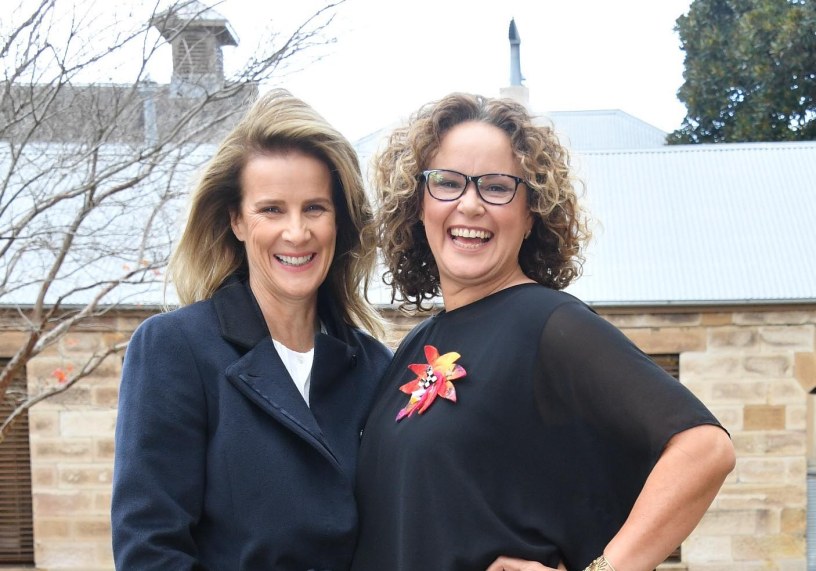Rachel Griffiths and Leah Purcell at the launch of #SheDirects. (Photo credit: Fiona Sacco)
With Create NSW’s ‘50:50 by 2020’ gender equity target now at a halfway point, the New South Wales Government has announced a $100,000 development initiative to increase the number of women directing TV drama.
The program, titled #SheDirects, will fund the development of up to four one-hour TV drama projects with a female director and at least one other woman as part of the creative team.
Introducing the funding at The Mint in Sydney today, Minister for the Arts Don Harwin encouraged broadcasters to come on board by matching the government’s investment.
“With this initiative we’ll open up new opportunities that reduce the barriers for female directors in New South Wales, and indeed across the country,” he said.
“We’ll also ensure that New South Wales continues to attract quality, female-led productions.”
After recognising that women were poorly represented in key creative roles, Create NSW’s predecessor Screen NSW announced a gender equity target in November 2015, with aims to achieve an even split across all development and production funding by 2020.
In 2014-15, only 44 per cent of successful applicants for funding from Screen NSW had female key creatives – in 2017-18, that figure is now at 53 per cent.
But as Create NSW acting executive director Grainne Brunsdon told IF last month, “the challenge is to maintain that average.”
“It will take constant work, particularly with the number of women directing TV dramas.”
In 2014-15, only 35 per cent of Screen NSW’s approved productions had female directors attached across both film and television projects – today that figure is 45 per cent.
Speaking at the #SheDirects launch, director and actor Rachel Griffiths said she had noted with surprise the absence of female producers and directors when her career took her to the UK and US.
That was as she had been inspired back in Australia by the work of women like Jan Chapman, Gillian Armstrong, Jocelyn Moorhouse and Nadia Tass, as well as Kiwis Niki Caro and Jane Campion.
“But the truth is that these women were actually outliers – that when the data came in, our record did not back up the visuals. We did not have more girls in the saddle, just very successful ones.”
Griffiths said it was “inarguable” that Australian film had a better track record than Australian TV in promoting diverse perspectives of the female experience on screen.
“I hope that the ‘50:50 by 2020’ might flow upstairs to some board rooms where both the opportunities for deep change and the foundations of deep resistance can be found.”
However, she said it had been exciting to see more complex depictions of women – beyond the tropes of “likeable, fuckable, adorable” – of late on shows like Mystery Road, Wentworth, Picnic at Hanging Rock, Dead Lucky, Top of the Lake and Redfern Now.
Too frequently female characters were “under-written and under-observed”, she said.
“Often in television, we’re used by lazy writers and producers who can think of nothing more interesting this week than let’s have her have sex with X, or discover she’s a lesbian – for an episode.
“I believe female directors fight more for their female characters; we defend them against statements like ‘But will we like her? Is she too angry? Is she hot enough, skinny enough?’
“Rather we’ll say: ‘We’ll make you care, because I can put you, the audience, in her shoes. You will love her because she’s flawed, dynamic, challenging, smart, powerful and authentic.'”
Director, writer and actor Leah Purcell also spoke at the launch, using the opportunity to point out that her TV directing career was an example of what can happen when someone is given opportunity and access.
“I came through the Indigenous sector, where I was supported as an emerging director in initiatives such as Short Black, which led up to my directing gigs on TV which were Redfern Now, Cleverman and The Secret Daughter – which, by the way, was the first time an Indigenous woman ever had been a start-up director on a drama series on Australian commercial TV.
“I am a result of initiatives, targets and quotas. Especially given the fact I didn’t go to any sort of film school, writing school or acting school – so I needed all the bloody help that I could get. I was a young black girl from the bush who had dreams and aspirations to be in the entertainment industry, and #SheDirects will do the same for others.”
Applications for #SheDirects are open until August 5. Guidelines here.


